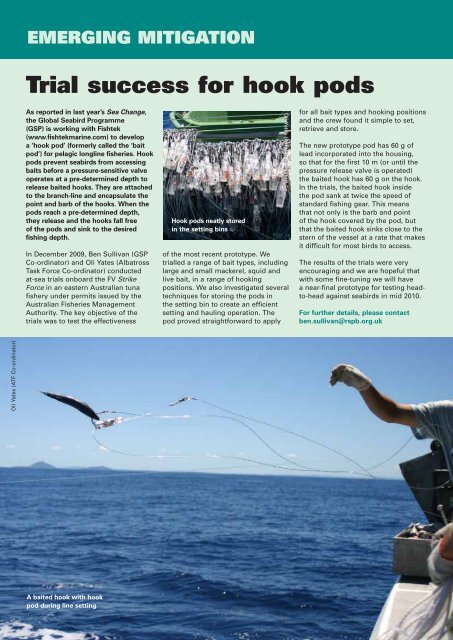'Petrel discoverer' Hadoram Shirihai - RSPB
'Petrel discoverer' Hadoram Shirihai - RSPB
'Petrel discoverer' Hadoram Shirihai - RSPB
Create successful ePaper yourself
Turn your PDF publications into a flip-book with our unique Google optimized e-Paper software.
Oli Yates (ATF Co-ordinator)<br />
EMERGING MITIGATION<br />
Trial success for hook pods<br />
As reported in last year’s Sea Change,<br />
the Global Seabird Programme<br />
(GSP) is working with Fishtek<br />
(www.fishtekmarine.com) to develop<br />
a ‘hook pod’ (formerly called the ‘bait<br />
pod’) for pelagic longline fisheries. Hook<br />
pods prevent seabirds from accessing<br />
baits before a pressure-sensitive valve<br />
operates at a pre-determined depth to<br />
release baited hooks. They are attached<br />
to the branch-line and encapsulate the<br />
point and barb of the hooks. When the<br />
pods reach a pre-determined depth,<br />
they release and the hooks fall free<br />
of the pods and sink to the desired<br />
fishing depth.<br />
In December 2009, Ben Sullivan (GSP<br />
Co-ordinator) and Oli Yates (Albatross<br />
Task Force Co-ordinator) conducted<br />
at-sea trials onboard the FV Strike<br />
Force in an eastern Australian tuna<br />
fishery under permits issued by the<br />
Australian Fisheries Management<br />
Authority. The key objective of the<br />
trials was to test the effectiveness<br />
A baited hook with hook<br />
pod during line setting<br />
Hook pods neatly stored<br />
in the setting bins<br />
Oli Yates (ATF Co-ordinator)<br />
of the most recent prototype. We<br />
trialled a range of bait types, including<br />
large and small mackerel, squid and<br />
live bait, in a range of hooking<br />
positions. We also investigated several<br />
techniques for storing the pods in<br />
the setting bin to create an efficient<br />
setting and hauling operation. The<br />
pod proved straightforward to apply<br />
for all bait types and hooking positions<br />
and the crew found it simple to set,<br />
retrieve and store.<br />
The new prototype pod has 60 g of<br />
lead incorporated into the housing,<br />
so that for the first 10 m (or until the<br />
pressure release valve is operated)<br />
the baited hook has 60 g on the hook.<br />
In the trials, the baited hook inside<br />
the pod sank at twice the speed of<br />
standard fishing gear. This means<br />
that not only is the barb and point<br />
of the hook covered by the pod, but<br />
that the baited hook sinks close to the<br />
stern of the vessel at a rate that makes<br />
it difficult for most birds to access.<br />
The results of the trials were very<br />
encouraging and we are hopeful that<br />
with some fine-tuning we will have<br />
a near-final prototype for testing headto-head<br />
against seabirds in mid 2010.<br />
For further details, please contact<br />
ben.sullivan@rspb.org.uk

















